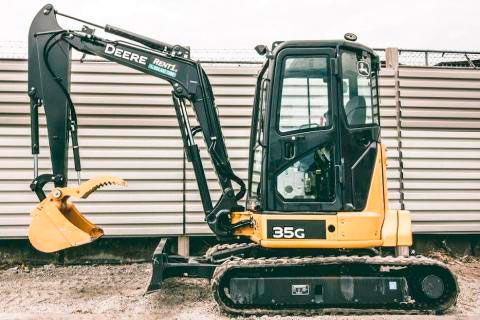John Deere 35G Controls and How to Use Them
Congratulations! You are now an owner or operator of one of the most versatile, capable, and cost-efficient excavators in the world – the John Deere 35G mini excavator. Designed and built with you in mind, the 35G can be used in many industries – construction, agriculture, lawn care – and excels in many tasks: digging, excavating, removing debris, and spreading soil, just to name a few. With more than 100 optional accessories, the John Deere 35G can get the job done, no matter what.

If you are familiar with John Deere machinery, then you have a leg-up on the competition because you understand 35G controls and how to use them. If you have never operated a 35G or other John Deere products, the learning curve is not significant. It is your responsibility to understand the control systems from beginning to end, and you are strongly encouraged to read through all manufacturer-supplied operator and maintenance manuals. John Deere also offers a controls simulation program for further reference.
As the industry leader in heavy machinery, John Deere has achieved its position through best-in-class products and services. In addition to the documentation provided, the company offers an extensive service and support program. For specific questions about your 35G excavator controls, you also may the John Deere Product Training website, where you can learn about learning opportunities through John Deere University (a web-based learning program available 24/7), Operator Training, and customized Instructor Led Training curriculum.
35G Specific Controls
Only one of John Deere’s G-Series of compact excavators, the 35G is “small” yet comfortable. The cab is spacious, with the seat, pedals, and controls positioned to make it easy for big operators to use. The windows are large, giving you a nearly 100 percent unobstructed view of the job site and people around you. Controls and monitors that you can easily access in the 35G are:
- Horn.
- Horn meter.
- Gauges and Instrumentation lights: fuel level gauge / left run indicator / tachometer / right turn indicator / engine coolant temperature gauge / service alert indicator / hydraulic oil temperature / electrohydraulic hitch indicator / neutral indicator / high exhaust temperature indicator / exhaust filter indicator / exhaust filter disabled indicator / engine air cleaner restriction indicator / engine information indicator / transmission information indicator / information display for speedometer, hour meter, transmission speed selection, PTO speed, diagnostic trouble codes, on-board diagnostics information / trailer 2 indicator / charging system indicator / MFWD-engaged indicator / PTO-engaged indicator / high beam indicator / differential lock indicator / park brake indicator / vehicle indicator / trailer 1 indicator / stop indicator / vehicle information display / PTO icon / hour meter icon
- Monitoring systems: Preheat indicator / Engine oil pressure indicator with alarm / Alternator voltage indicator / Fuel gauge and low-fuel-level indicator / Engine coolant temperature gauge and engine coolant temperature indicator with alarm / Hour meter / Work lights indicator
- Motion alarm with a cancel switch.
- Work lights and switch.
- Propel levers and foldable pedals.
- Automatic shifting and two travel speeds.
- 2-inch retractable seat belt.
- 3-inch retractable seat belt.
- Fore and aft adjustment controls for the seat.
- Cloth suspension seat.
- Front screen.
- Rear secondary exit.
- 12-volt accessory outlet for charging.
- 55-amp alternator controls.
- Access panels for fuses and circuits.
- JDLink™ wireless communication system (available in specific countries, see your dealer for more information).
- Halogen work light mounted inside the cabin.
Help! My John Deere Indicator Lights are Going Crazy!
Whether you are an experienced owner-operator or a newbie graduate straight out of John Deere University, some of the indicator lights in your 35G may be obscure. When they suddenly go on or begin flashing, you may feel a sense of dread. Here are some things to keep in mind:
- When the red “STOP” light flashes, turn the engine off immediately. This means a serious malfunction has occurred.
- The yellow “CAUTION” light may go on, meaning the engine is on but the handbrake is engaged. There may also be a warning sound.
- The HAZARD lights are on. These work just as they do in your car or other vehicles, meaning you have turned them on temporarily.
- The light for coolant temperature goes on, meaning the engine could be overheating.
- The transmission / hydraulic light indicator is on, meaning you should shut the engine off immediately and get the machine serviced.
- The engine oil pressure light comes on, meaning you need to check oil levels.
- Headlight indicator tells you whether the normal or bright headlights are on.
- The alternator indicator light comes on, meaning you should check alternator cables or take the excavator in for service.
These are just some of the lights in your 35G.
Standard Controls – ISO
Controls for the 35G or other John Deere excavators, or those made by other manufacturers, are based on standards set by the International Organization for Standardization (ISO). These controls are the most commonly used worldwide, regardless of language or culture. For ISO-specific controls which are used in John Deere excavators, the left-hand joystick controls Swing (left and right) and Stick Boom (away from and closer to the machine), while the right-hand joystick controls up and down for the Main Boom and close and dump for the Bucket. Here are the specifics:
- Left hand left = Swing left.
- Left-hand right = Swing right.
- Left hand forward = Stick Boom (Dipper) away.
- Left hand back = Stick Boom (Dipper) close.
- Right hand left = Bucket curl in (closed)
- Right-hand right = Bucket curl out (dump)
- Right hand forward = Main Boom down.
- Right hand back = Main Boom up…
Change the Control Patter
As an operator familiar with John Deere controls, you could work the machine in your sleep. But what if you ever need to change the control pattern? Follow these steps:
- Find the pattern control changer; always located underneath the seat.
- Use the key to unlock the box.
- Loosen the lever by unscrewing the bolt.
- Now, change the pattern by turning the lever.
- To keep the level in position and make sure it does not vibrate with the excavator is operating, simply replace the bolt to keep the lever in position.
- Finally, re-lock the box and you are done.
Some older models and from other manufacturers make this progress messy and difficult. You may have to access the junction box or control valve assembly to get the four pilot hoses you will need to work with. John Deere makes this simple by following the steps outlined above.
Need Help Controlling Owner and Operator Costs?
Operating and realizing a profit from your investment in a John Deere 35G is only part of the equation of achieving your career or job-specific objectives. Many issues come up which can affect your bottom line, everything from maintenance tasks to transporting your excavator back-and-forth to fuel and storage expenses. It is enough to make your brain spin, but thankfully there are manufacturer-sponsored options to help you succeed.
John Deere can help, through its Customer Personnel Service (CPS), its forward-thinking, confront-before-failure plan set for machinery maintenance. The program – again, designed and implemented with owners and operators in mind – can help manage expenses, reduce stress, and help build profitability. Staffed by highly trained and experienced professionals, including many who previously worked as owners or operators, the program offers the following components:
- Fluid Analysis Program. Ever wondered when it was time to change your oil? How about replacing hydraulic fluid? The fluid analysis program helps minimize downtime which could end catastrophically, maximize drainage intervals, and help save money in the long run. John Deere specialists use the latest technology, equipment, and best-in-class methodology to help you know when fluid changes are needed, or when it is time to recondition your engine, transmission, hydraulics – and even trade-in your excavator for a new model. This program is included in any Extended Warranty and Planned Maintenance Agreement.
- Planned or Preventive Maintenance (PM) Agreements. Interested in locking in maintenance expenses for a fixed timeframe at a fixed cost? John Deere’s PM agreements allow you to do just that. All manufacturer-suggested maintenance gets done on time, on on-site whenever or wherever you need it.
- Extended Coverage maintenance plans also are available and focus on machine repairs. EC plans are honored by all John Deere construction dealers and are customizable, so you can effectively manage your operating costs.
- Component life-cycle data. This is where John Deere’s expert “number crunchers” come into play, giving you critical information on the expected lifetime of your machinery and components. This data helps inform the decision-making process for maintenance, telling you how many hours you can expect from the engine, transmission, hydraulic pump, and other vital components.
For the ultimate peace-of-mind, John Deere has Customer Support Advisors (CSAs) on staff to help you make important maintenance, repair, or trade-in decisions for your excavator. Personal service means that each CSA is committed to helping you make decisions that are in your best interests.

